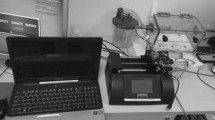Abstract
Background
During the past few years, a variety of energy-based techniques for vessel ligation have been introduced. With the use of a porcine model and different devices for bipolar vessel sealing (BiClamp and LigaSure), we studied the impact of different clamp surface structures on the efficacy and quality of vessel sealing.
Methods
Eight Swabian Hall pigs underwent splenectomy, nephrectomy, salpingo-oophorectomy, and small bowel resection with the use of bipolar vessel sealing devices designed for open and laparoscopic surgery. Vessel sealing with clamps with a smooth (nonstructured) surface (BiClamp for open surgery and LigaSure for laparoscopic surgery) was compared to that of clamps with a structured (grooved, wafer-like) surface (BiClamp for laparoscopic surgery and LigaSure for open surgery). Measurements of sealed vessels (2- to 7-mm diameter) included the seal failure rate, instrument sticking, and heat-associated morphological vascular wall alterations.
Results
Analysis of seal failures did not reveal significant differences between the different devices for both open [BiClamp, 17.9% (17/95); LigaSure, 15.5% (11/71)] and laparoscopic surgery [BiClamp, 2.8% (1/36); LigaSure, 8.6% (3/35)]. Comparing all data of structured versus smooth clamp surfaces, the seal failure rate was lower using clamps with a structured (11.2%) compared to a smooth surface (15.4%). Instrument sticking and thermal spread were found to be significantly increased after sealing with structured surfaces, regardless of whether devices designed for open (p < 0.05 and p < 0.001, respectively) or laparoscopic surgery (p < 0.001 and p < 0.01, respectively) were used.
Conclusion
Clamps with a structured surface seem to be superior to those with a smooth surface for successful bipolar vessel sealing, as indicated by an increase of thermal spread. However, the more pronounced instrument sticking represents an undesired side effect and should encourage the search for more inert materials to further improve the sealing procedure.



Similar content being viewed by others
References
Belli G, Fantini C, Ciciliano F, D’Agostino A, Barberio M (2003) Pancreaticoduodenectomy in portal hypertension: use of the LigaSure. J Hepatobiliary Pancreat Surg 10: 215–217
Campbell PA, Cresswell AB, Frank TG, Cuschieri A (2003) Real-time thermography during energized vessel sealing and dissection. Surg Endosc 17: 1640–1645
Dubuc-Lissoir J (2003) Use of a new energy-based vessel ligation device during laparoscopic gynecologic oncologic surgery. Surg Endosc 17: 466–468
Harold KL, Pollinger H, Matthews BD, Kercher KW, Sing RF, Heniford BT (2003) Comparison of ultrasonic energy, bipolar thermal energy, and vascular clips for the hemostasis of small-, medium-, and large-sized arteries. Surg Endosc 17: 1228–1230
Heniford BT, Matthews BD, Sing RF, Backus C, Pratt B, Greene FL (2001) Initial results with an electrothermal bipolar vessel sealer. Surg Endosc 15: 799–801
Kennedy JS, Stranahan PL, Taylor KD, Chandler JG (1998) High-burst-strength, feedback-controlled bipolar vessel sealing. Surg Endosc 12: 876–878
Klioze SD, Poppas DP, Rooke CT, Choma TJ, Schlossberg SM (1994) Development and initial application of a real time thermal control system for laser tissue welding. J Urol 152: 744–7481
Landman J, Kerbl K, Rehman J, Andreoni C, Humphrey PA, Collyer W, Olweny E, Sundaram C, Clayman RV (2003) Evaluation of a vessel sealing system, bipolar electrosurgery, harmonic scalpel, titanium clips, endoscopic gastrointestinal anastomosis vascular staples and sutures for arterial and venous ligation in a porcine model. J Urol 169: 697–700
Levy B, Emery L (2003) Randomized trial of suture versus electrosurgical bipolar vessel sealing in vaginal hysterectomy. Obstet Gynecol 102: 147–151
Palazzo FF, Francis DL, Clifton MA (2002) Randomized clinical trial of LigaSure versus open haemorrhoidectomy. Br J Surg 89: 154–157
Presthus JB, Brooks PG, Kirchhof N (2003) Vessel sealing using a pulsed bipolar system and open forceps. J Am Assoc Gynecol Laparosc 10: 528–533
Romano F, Caprotti R, Franciosi C, De Fina S, Colombo G, Sartori P, Uggeri F (2003) The use of LigaSure during pediatric laparoscopic splenectomy: a preliminary report. Pediatr Surg Int 19: 721–724
Romano F, Caprotti R, Franciosi C, De Fina S, Colombo G, Uggeri F (2002) Laparoscopic splenectomy using LigaSure. Preliminary experience. Surg Endosc 16: 1608–1611
Schulze S, Krisitiansen VB, Fischer Hansen B, Rosenberg J (2002) Sealing of cystic duct with bipolar electrocoagulation. Surg Endosc 16: 342–344
Sengupta S, Webb DR (2001) Use of a computer-controlled bipolar diathermy system in radical prostatectomies and other open urological surgery. ANZ J Surg 71: 538–540
Shamiyeh A, Schrenk P, Tulipan L, Vattay P, Bogner S, Wayand W (2002) A new bipolar feedback-controlled sealing system for closure of the cystic duct and artery. Surg Endosc 16: 812–813
Shigemura N, Akashi A, Nakagiri T (2002) New operative method for a giant bulla: sutureless and stapleless thoracoscopic surgery using the LigaSure system. Eur J Cardiothorac Surg 22: 646–648
Sigel B, Dunn MR (1965) The mechanism of blood vessel closure by high frequency electrocoagulation. Surg Gynecol Obstet 121: 823–831
Spivak H, Richardson WS, Hunter JG (1998) The use of bipolar cautery, laparosonic coagulating shears, and vascular clips for hemostasis of small and medium-sized vessels. Surg Endosc 12: 183–185
Strasberg SM, Drebin JA, Linehan D (2002) Use of a bipolar vessel-sealing device for parenchymal transection during liver surgery. J Gastrointest Surg 6: 569–574
Acknowledgments
We thank Janine Becker and Elisabeth Gluding for excellent technical assistance. The study was supported by ERBE Elektromedizin (Tübingen, Germany).
Author information
Authors and Affiliations
Corresponding author
Rights and permissions
About this article
Cite this article
Richter, S., Kollmar, O., Schilling, M.K. et al. Efficacy and quality of vessel sealing. Surg Endosc 20, 890–894 (2006). https://doi.org/10.1007/s00464-005-0380-6
Received:
Accepted:
Published:
Issue Date:
DOI: https://doi.org/10.1007/s00464-005-0380-6




